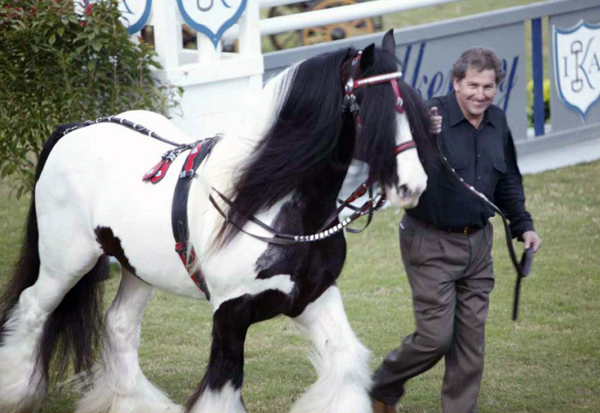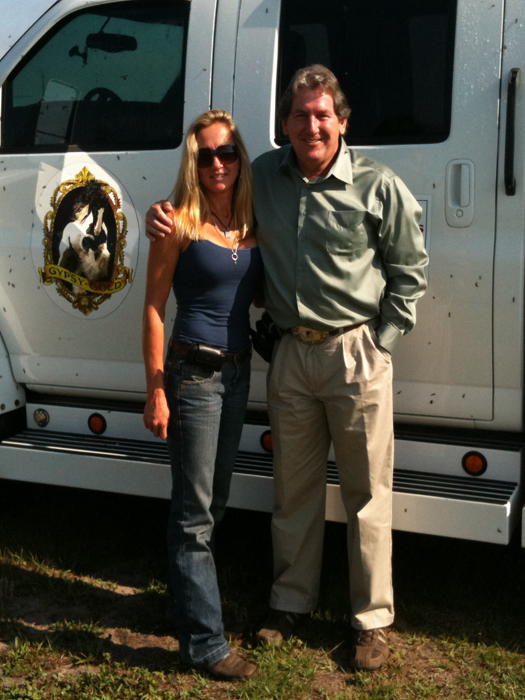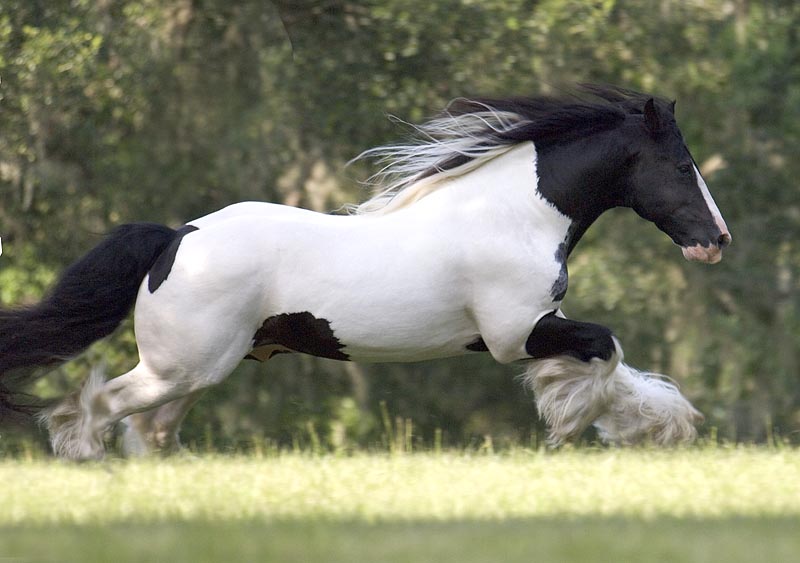Interview with Gypsy Vanner Founder Dennis Thompson
Recently, I posted photos of a cart for sale at a local furniture store, and asked readers if they knew anything about it. Now, I kinda still live in this little bubble of "nobody really reads my blog, right?" Even though I get hundreds of hits, I don't really know who reads it, or if they are all just hits from people looking for random horse pictures, copying them to their tumblr pages, and moving on without reading. I still think it's just my parents.So I was pleasantly surprised when I received an email from some dude, telling me that the cart I found is what's called a "Turkish Gypsy Potter's Cart." The message went on to tell me that I had some errors on my "What is a Gypsy Horse" page, about the history of the breed, the different names, etc.So I was all like, "Who does this guy think he is, telling me my carefully written and researched paper is all wrong?"Dennis Thompson, that's who.Gulp.Humble pie, anyone?Yeah, this dude who just sent me an email because he read something I wrote and wanted to comment on it, is probably the biggest expert on Gypsy Horses in the U.S.Why, you ask?He brought them here. Dennis and his late wife, Cindy were on a business trip in England when they came across what would be the first Gypsy Vanner horse, a stallion named Cushti Bok. Read all about their discovery here. After four years, many trips back and forth to England and Wales, meeting the Gypsies and immersing themselves in their culture, Dennis and Cindy brought the first Gypsy Vanners to America, and founded the Gypsy Vanner Horse Society. Cushti Bok (meaning "Good Luck" in the Romani language) became the first horse in the registry.
Dennis and his late wife, Cindy were on a business trip in England when they came across what would be the first Gypsy Vanner horse, a stallion named Cushti Bok. Read all about their discovery here. After four years, many trips back and forth to England and Wales, meeting the Gypsies and immersing themselves in their culture, Dennis and Cindy brought the first Gypsy Vanners to America, and founded the Gypsy Vanner Horse Society. Cushti Bok (meaning "Good Luck" in the Romani language) became the first horse in the registry. This tale is well documented, and I had read it before. I have always been blown away by their story. Dennis and Cindy's love for horses, their non-judgmental curiosity of the Roma culture, and their dedication in establishing a new breed registry here in the states - it could be a novel. (Or at least an All Creatures Great and Small type PBS/BBC series. Come on. That idea is gold. Why am I not a TV producer??)But besides the original tale, I really didn't know much about the Thompsons. I'm always wanting to know more. Someone recently told me that I have the "inquirer" default - always asking questions. But without questions, how do you get answers?Over the past few years, looking for lots of answers about Gypsy Horses, I have done so much reading. I find out about the breed: where they came from; proper conformation; stallions; what to do when your horse gets scratches; all sorts of things. And you end up visiting tons and tons of breeder websites. They will show you their stallions, mares, foals, and even show you around the barn sometimes. But for whatever reason, people remove their personality from their business presence on the web. A big disservice to potential clients, if you ask me.The whole reason you visit the indie bookstore before you go to Barnes & Noble is because you like the store owners, and want to support them. Or your town's ancient hardware store over Home Depot. When you are buying a horse—a living, breathing piece of inventory, who can actually take on aspects of its owner's personality—why wouldn't you want to know more about them?
This tale is well documented, and I had read it before. I have always been blown away by their story. Dennis and Cindy's love for horses, their non-judgmental curiosity of the Roma culture, and their dedication in establishing a new breed registry here in the states - it could be a novel. (Or at least an All Creatures Great and Small type PBS/BBC series. Come on. That idea is gold. Why am I not a TV producer??)But besides the original tale, I really didn't know much about the Thompsons. I'm always wanting to know more. Someone recently told me that I have the "inquirer" default - always asking questions. But without questions, how do you get answers?Over the past few years, looking for lots of answers about Gypsy Horses, I have done so much reading. I find out about the breed: where they came from; proper conformation; stallions; what to do when your horse gets scratches; all sorts of things. And you end up visiting tons and tons of breeder websites. They will show you their stallions, mares, foals, and even show you around the barn sometimes. But for whatever reason, people remove their personality from their business presence on the web. A big disservice to potential clients, if you ask me.The whole reason you visit the indie bookstore before you go to Barnes & Noble is because you like the store owners, and want to support them. Or your town's ancient hardware store over Home Depot. When you are buying a horse—a living, breathing piece of inventory, who can actually take on aspects of its owner's personality—why wouldn't you want to know more about them? After perusing a farm's website, I'm always left wondering, how did you get into horses? Do you train them yourself? Does your whole family get into it? Where do you live? Do you like Star Wars? Tell me about YOU.This is pretty much the question I posed to Mr. Thompson (okay, maybe not the Star Wars bit), after thanking him for his comment and his offer to help me correct my heinous misinformation. (Yes, it's HEINOUS! I hate being wrong. If you'd like to read the revised version of my "What is a Gypsy Horse" page, click here.) And he was kind enough to oblige.
After perusing a farm's website, I'm always left wondering, how did you get into horses? Do you train them yourself? Does your whole family get into it? Where do you live? Do you like Star Wars? Tell me about YOU.This is pretty much the question I posed to Mr. Thompson (okay, maybe not the Star Wars bit), after thanking him for his comment and his offer to help me correct my heinous misinformation. (Yes, it's HEINOUS! I hate being wrong. If you'd like to read the revised version of my "What is a Gypsy Horse" page, click here.) And he was kind enough to oblige.
Dennis Thompson Interview
- Thank you for allowing me to interview you!
Hello Heidi, it is my pleasure. It has been seventeen years since my late wife and I brought the first Gypsy Vanner Horses to North America and people still have many questions about the Vanner breed.
- Tell us a little bit about yourself.
I was born in Indiana to a father who was an educator and a mother who owned the first McDonalds in America with a hitching post—yes it was in Indiana Amish country. I was an extreme animal lover as a child with 150 rabbits, pet skunks, snakes, you name it I had it. They called me The Guppy God in grade school because I had 50 aquariums in my home and would take Mason jars of baby Guppies to school to sell for 5 cents each. A pet store that I frequented ask me to work for them when I was a teenager. That store was owned by Ed Lowe, the man who invented Kitty Litter. I would wind up managing his stores and then spent the rest of my adult career in the animal products industry designing products for animals and setting up distribution in the animal products industry world wide. I currently live in Ocala Florida on my farm called Gypsy Gold.
- What is the first horse you remember? How did this horse affect you?
Horses have been my passion for my entire life, first the neighbor's Shetland Ponies, then another neighbor's paint horse named Lady and then my own American Quarter Horse named Presto Dial, a son of the late, great Johnny Dial.
- Did you come from a horse family?
I was the first [in my family] to have a passion for horses and all animals.
- How long was it before you were able to have your own horse?
In the fifties, my neighbor had Shetland Ponies he kept in an apple orchard and I had a large Willow tree in my front yard. I would fashion bridles from the willow branches and ride the ponies in the orchard until they made a mad dash for the barn and my reins broke. That happened over and over so the passion was bigger than the pain.
- Tell us about YOUR first horse.
Presto, was a very beautiful classic looking Quarter horse. The kind that might be referred to as a foundation Quarter Horse today. The Quarter Horse breed has changed. I hope the Vanner breed does not do the same.
- How did you find out about Gypsy Horses?
My late wife and I discovered the Gypsy Vanner Horse . Stimulated by the look of one stallion standing in a farmer's field in England, we discovered that the horse belonged to a Traveler and that he had a band of mares that looked just like this stallion that he kept hidden. We would spend that day in a Gypsy camp, become the first Americans to ever attend Appleby Horse Fair with the sole intention of understanding Gypsies and their horses. We would trace the genetic history of that stallion through three countries, uncover the unknown vision he was born from, trace that vision back to two stallions that existed soon after World War II (Sonny Mays and The Coal Horse), Identify most of the great stallions and mares that developed over the next 60 years, name the breed and established the first breed registry in the world for a selectively bred horse developed by Gypsies, The Gypsy Vanner Horse Society.
- Gypsies are not an inexpensive breed. What about these horses "sold" you on the idea of owning one?
If I say Gypsy horse, the statement about not being expensive is true, if I say Gypsy Vanner Horse the statement is false.A very high percentage (possibly 80%) of the horses raised by Gypsies (Gypsy horses) are not a breed, they are a type of horse of unknown heritage and often have smooth-legged genetics, like Connemara or Irish Draft.The Gypsy Vanner Horse or Vanner is a specific looking horse born from a vision to create the perfect caravan horse. The look is that of a small Shire with more feather, more color and a sweeter head; an average-size horse with a draft horse body.Hair is an additive or cumulative gene (recessive), so nothing but hairy-legged horses developed the Vanner breed. The Dales Pony in the opinion of Fred Walker (King of the Coloured Horses) was paramount in the breed's development (not the Fells Pony).The Dales brought down the size, kept the feather and heavy bone and put the sweet head on them.Yes, some have Fells Pony in them but those have a lighter body look and are therefore not the breed's bulls-eye genetic or look.You can buy a Gypsy horse colt for 100 BPS, a Vanner colt will cost ten to 100 times that.
The look is that of a small Shire with more feather, more color and a sweeter head; an average-size horse with a draft horse body.Hair is an additive or cumulative gene (recessive), so nothing but hairy-legged horses developed the Vanner breed. The Dales Pony in the opinion of Fred Walker (King of the Coloured Horses) was paramount in the breed's development (not the Fells Pony).The Dales brought down the size, kept the feather and heavy bone and put the sweet head on them.Yes, some have Fells Pony in them but those have a lighter body look and are therefore not the breed's bulls-eye genetic or look.You can buy a Gypsy horse colt for 100 BPS, a Vanner colt will cost ten to 100 times that.  Horses raised by Gypsies of unknown heritage are called Trade Horses, Export Horses, Knacker Horses or Coloured Riding Horses and are raised as a commodity-based animal for the restaurant business in Belgium, Holland, and France.All horses raised by Gypsies were called Coloured Horses or Coloured Cobs, nothing else, there was no differentiation between the breed and the type. Gypsy Vanner Horse is the first name in the world to separate the breed from the type, that is why the name Vanner is so important—it holds the breed's vision and promise.The best and most expensive horses Gypsies raise (their breed) are hidden.If you had five dollars you would leave it on the kitchen table. If you had ten thousand dollars you would hide it. The Vanner breed is often hidden, while common horses raised by Gypsies are not.
Horses raised by Gypsies of unknown heritage are called Trade Horses, Export Horses, Knacker Horses or Coloured Riding Horses and are raised as a commodity-based animal for the restaurant business in Belgium, Holland, and France.All horses raised by Gypsies were called Coloured Horses or Coloured Cobs, nothing else, there was no differentiation between the breed and the type. Gypsy Vanner Horse is the first name in the world to separate the breed from the type, that is why the name Vanner is so important—it holds the breed's vision and promise.The best and most expensive horses Gypsies raise (their breed) are hidden.If you had five dollars you would leave it on the kitchen table. If you had ten thousand dollars you would hide it. The Vanner breed is often hidden, while common horses raised by Gypsies are not.
- How/when did you decide to implement a breeding program, and what do you look for in a stallion or broodmare?
I am the first breeder in North America and imported the first two stallions and fourteen mares. I breed for the same vision Gypsies had for their perfect caravan horse or Vanner (a horse suitable to pull a caravan in the English Chambers Dictionary) Heavy hips, broad chest, short back, heavy flat bone (at the knee) feather that starts at the knee in the front and hock in the back that covers the front of the hooves. (Breed standard)
- Do you have a trainer, or do it yourself?
I hire trainers who embrace modern techniques.
- Do you attend shows?
I did in the beginning but not anymore. It is very common for horses who win at shows to trace back to the original sixteen horses my late wife Cindy and I brought to America.
- What riding or driving disciplines do you prefer? (western, dressage, carriage driving, etc.)
I wrote the mission statement of the GVHS and in that mission it talks about how the perfect caravan horse is suitable for any number of equine disciplines. That was the only thing about the mission I did not have great passion about. To my surprise they are amazingly versatile and can do anything, including jump. I own Breyer and Vogue model, The Gypsy King. He was trained in the art of Dressage by an eighty + time USDA champion, gold medalist and Olympic contender for the Olympics in China for 2008. She called me just before the World Equestrian Games at the Kentucky Horse Park and said "He's one of the most extraordinary horses of any breed I have ever ridden in my life"Quite a statement from a rider of her caliber! Yes, they can do anything.
- Do your horses interact with the public?
I give tours to as many as 100 people per week, those people all interact with the horses. I coined the phrase "Golden Retriever With Hooves" and they certainly are. If you would like, one day I will expand on why I believe their temperament is in their feather.
- I Would LOVE to hear more about that!
- What's next for your farm?
The process of trying to establish a breed in the age of the Internet is challenging. I would like to create a better way for breeds to maintain the look and temperament (the pure vision) they were born from.History tells us that breeds change or why would there be two Morgan Horses, why doesn't the Quarter Horse look the same, why does a German Shepherd walk up hill, the list goes on and on.I have pondered why and have identified the problem and the solution. I want the Gypsies Vanner Horse to keep its magic forever.Me too, Dennis. I hope you, and we as members, are able to keep Fred Walker's dream alive. Thanks so much to you and Cindy for all of your tireless efforts in bringing this special horse to America, and for maintaining the breed standards set by the originators of the breed, the Gypsies. OK so I guess more than just my parents read my blog. :)Thanks Dennis!Here's another recent article with Dennis going further into the breed's history.Please feel free to use the comment form below, and thanks for reading.
OK so I guess more than just my parents read my blog. :)Thanks Dennis!Here's another recent article with Dennis going further into the breed's history.Please feel free to use the comment form below, and thanks for reading.

